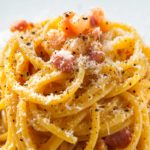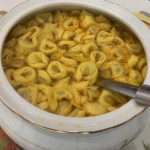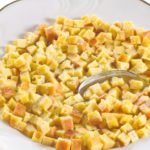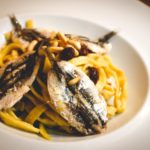TAJARIN WITH TRUFFLE
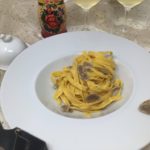
Wider than “angel’s hair” pasta but thinner than tagliatelle noodles, tajarin (tagliolini noodles in the Piedmont dialect) were made in the Langhe and Monferrato area farmsteads, in the Piedmont region. From the 15th century, tajarin spread throughout Piedmont, as related in early chronicles.
It is a festive dish, enjoyed mainly during important celebrations. The generous quantity of
egg yolks in this amazing pasta makes it a “rich” dish, not the best choice
during the working week. Purists consider tajarin to be genuine when it
is made with at least 30 egg yolks per kilo of flour.
I enjoyed tajarin in Alba, a town in Piedmont that is famous for its sophisticated cuisine and famous “white truffle”.
The restaurant’s pièce-de-résistance was tajarin with white truffle
finely sliced with the special truffle slicer (done by the waiter at my table), tossed with Malga butter (a very fresh rich butter made in a shepherd’s cottage in the mountains). I made my own butter at home: I bought fresh whipping cream and put it in the bowl of a stand mixer, and whisked it at maximum speed until the fat content emulsified. Then I picked up the butter with wet hands and rolled it into balls which I plunged into a bowl of ice water. It only takes few
minutes.
Prep Time: 15 minutes | Cooking Time: 5 minutes | Total Time: 50 minutes | Yield: Makes 2 servings.
Ingredients
- 7 egg yolks (if the dough is too dry, you can add a few tablespoons of egg white)
- 2 cups (250 g) all-purpose flour
- 3 tbsp (40 g) butter
- 1 tin of crushed tomato
Instructions
On a wooden pastry board, pour the flour into a mound, make a hole in its centre and drop the egg yolks into it.
Mix by hand to make a dough that you are going to roll out using a rolling pin.
Let the dough sit for at least 30 minutes, wrap it in cling film or, even better, cover it in a glass bowl.
Roll the dough into a sheet about two millimetres (1/24-inch) thick. Let it dry for at least an hour and a half (depending on the season, in summer 15 minutes are usually enough. The sheet of dough must be dry enough not to stick when you roll it but still flexible to be rolled on itself without breaking).
Flour it lightly, fold a few times to form stacking layers and, using a knife, cut fettuccine about 2 millimetres wide (1/24 inch).
Boil them in salted water for a couple of minutes if they are fresh. If they are frozen, put them directly in the boiling water without thawing, and add a minute to cooking time.
Meanwhile, melt the butter in a pan, add the drained pasta and 3-4 tablespoons of cooking water, mix and serve. Slice the truffle directly on pasta in the dishes.

